Here are the results from the fourth year of our Market Garden Polyculture Study. This study looks at the differences between growing annual vegetables and herbs in polycultures vs growing them in traditional blocks.
In this post you will find an overview of the trial garden and the polycultures we are growing, a description of what we record and the 4th year results from the trial. You can find results from previous seasons on our website - https://www.thepolycultureproject.com/
If you would like to view this post with all of the tables and images you can find it here - http://balkanecologyproject.blogspot.com/2018/12/the-polyculture-market-garden-study.html
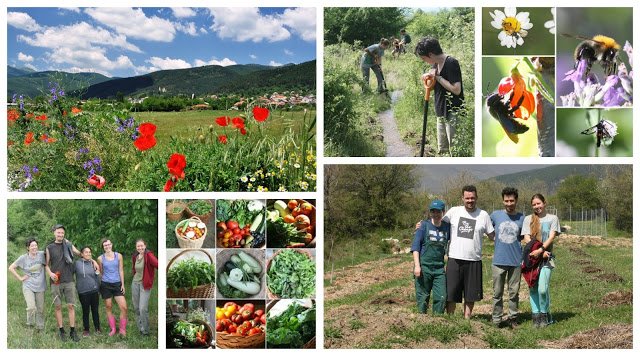
First of all we'd like to say a huge thank you to the team of volunteers that joined us for the study this year and that make it possible for us to carry out our experiments and research. It was a pleasure to work together with you :) Thank you Victoria Bezhitashvili, Angela Rice, Malcolm Cannon, Elise Bijl, Alex Camilleri, Daniel Stradner, Emilce Nonquepan, Ezekiel Orba and Chris Kirby Lambert.
It was a great a mix of people from all over the world including university students, a crypto fund manager, ex-nintendo web editor and market gardeners. Thank you all for your valuable input, it was our pleasure to host you and we look forward to seeing you again some day.
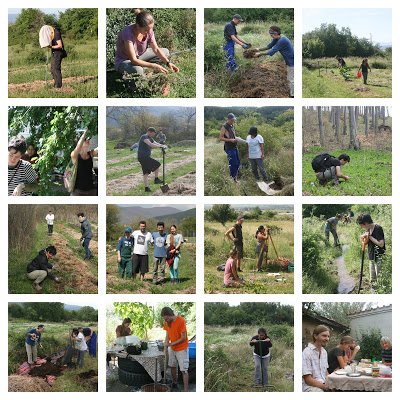
The Polyculture Study 2018 Team
Garden Overview
Location: Bulgaria, Shipka
Climate: Temperate
Köppen Climate Classification - Dfc borderline Cfb
USDA Hardiness Zone: 5b - 7a
Latitude: 42°
Elevation: 565 m
Average Annual Rainfall: 588.5 mm
Prevailing Wind: NW & NE
Garden Name: Aponia - Polyculture Market Garden
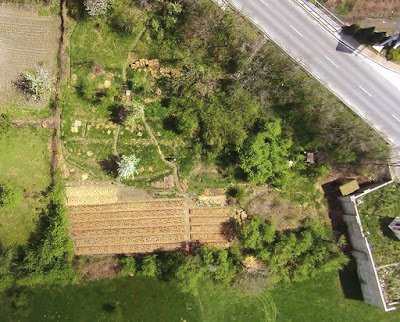
The six longer beds in the left hand corner of the photo on the right (the Aceaes) are the trial beds, the focus of this study.You can find the location of the Polyculture Market Garden on google maps here (labelled as Aponia on our Project map)
Garden area: 256.8 m2
Cultivated beds area: 165.6 m2
Paths: 50 cm wide - 91.2 m2
Bed Dimensions - 23 m x 1.2 m Area - 27.6 m2 per bed
Number of beds: 6
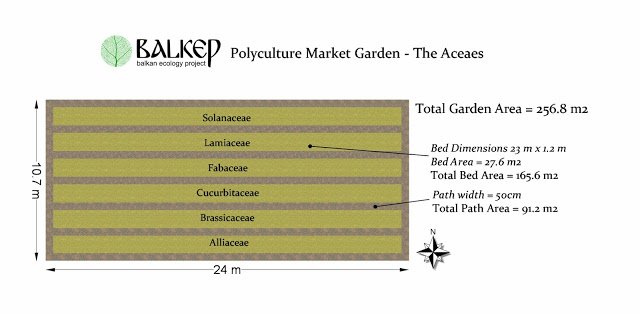
Study Area Path and Bed Layout
The beds are named after common vegetable families in order to familiarize participants with the use of Latin and introduce them to some major plants families. The bed names do not correspond to what is planted in the beds.
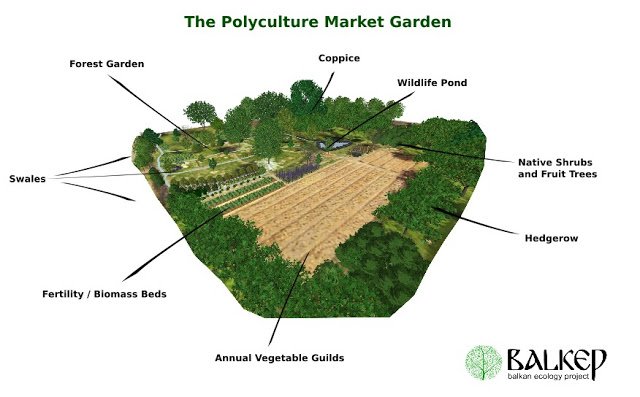
The Polycultures
We experiment with many polycultures and have developed a categorization system for ease of reference. They are categorized by life cycle i.e annual, perennial or combi (annuals and perennials) and further categorized by function. i.e support, infrastructure or production. Often a polyculture will provide multiple functions, but the primary function is what sets them to each category. I give all our polycultures nicknames. For example, all polycultures in the annual and production category are named after Stoic Philosophers.
The study is based on polycultures Zeno and Epictetus - both are annual/production polycultures. As we are looking to see how polycultures compare to conventional growing we also include a control for the Zeno polyculture i.e. the same crops from Zeno but planted in a more conventional block pattern. In the below illustration you can see the planting plan of the trial beds.
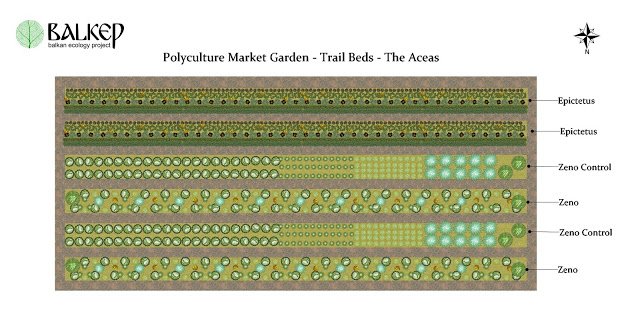
We scaled down to one bed of each polyculture and one bed of control for Zeno this year as opposed to the usual two of each as seen above. We have extrapolated from the data we recorded from each bed to keep the results comparable to the previous years.
Polyculture Zeno
We've been growing Zeno in the garden for around 10 years now. It's been very successful in our home gardens and in 2015 we scaled it up for the market garden.
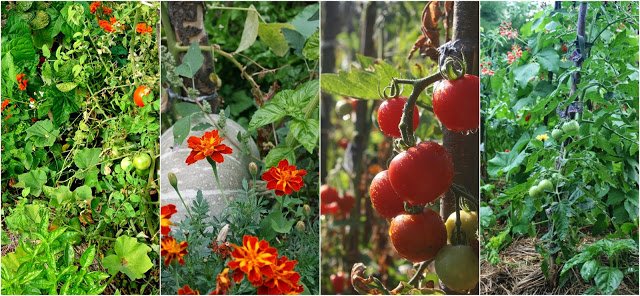
Photos from Zeno Polyculture
For more info on plant spacing, management and maintenance of this polyculture see a previous post here.
Zeno Plant List - The following plants and cultivars were used in this polyculture;
Tomato - Solanum lycopersicum 'Tigerella'
Tomato - Solanum lycopersicum 'Currant Sweet Pea' (not included in records)
French Beans - Phaseolus vulgaris 'Cobra'
French Beans - Phaseolus vulgaris - Local
Courgette - Cucurbita pepo 'Black Beauty'
White Bush Scallop - Cucurbita pepo
Butternut Squash - Cucurbita pepo 'Waltham Butternut'
Basil - Ocimum basilcium 'Napoletano Bollosi'
Pot Marigold - Calendula officinalis
Zeno Planting Scheme
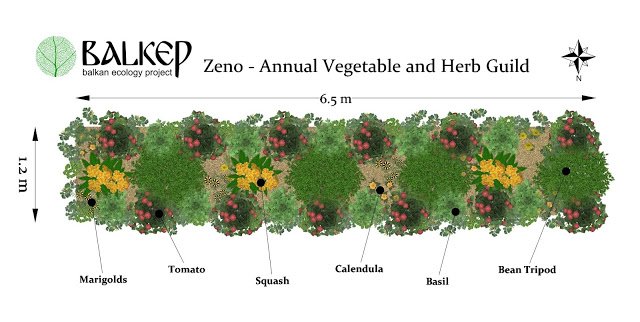
Zeno - Vegetable and herb polyculture/guild 6.5 m section of planting scheme
Zeno Control
The control includes all of the above plants but planted in blocks along the bed (see below). We want to see how the two planting schemes compare, i.e. whether or not the polyculture will produce more and the difference in the amount of time needed to cultivate the different layouts. The fertility inputs for both beds are the same.

Polyculture Epictetus
This is the fourth year we have tried this polyculture. It's basically a strip pattern of various vegetables from different plant families arranged to reduce pests and diseases, optimize space and nutrient share whilst respecting the individual plants needs for space and light.
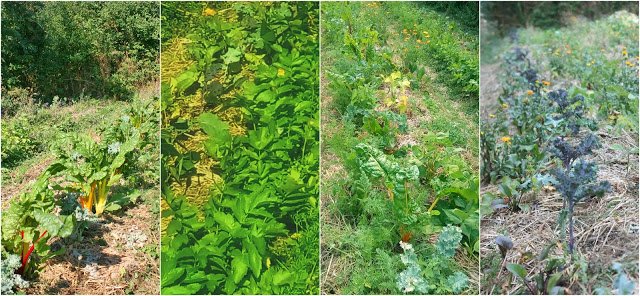
Epictetus Polyculture
Epictetus Plant List - The following plants and cultivars were used in this polyculture;
Beetroot - Beta vulgaris ' Bolthardy'
Dwarf Bean - Phaseolus vulgaris 'Rocquencourt'
Kale - Brassica napus 'Siberian'
Parsnip - Pastinaca sativa ' White Gem'
Turnip - Brassica rapa subsp. rapa 'Milan White'
Swiss Chard - Beta vulgaris subsp. cicla 'Rainbow Mix' (self seeded)
Pot Marigold - Calendula officinalis (self seeded)
Epictetus Planting Scheme
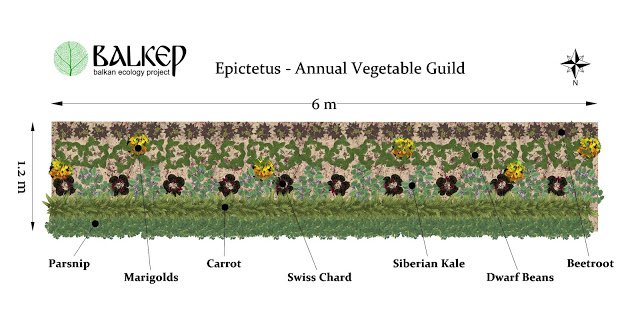
Example of Epictetus - Vegetable polyculture/guild - 6 m section of planting scheme
The table below shows the plant species composition of each of the beds including the dates that the plants were sown or planted.
We have not included a list of native wild plants that are encouraged to grow around the perimeter of each bed that we mow and apply as mulch to the beds during the growing season.
What we Record - Inputs
Time Input - We record how long it takes to develop, maintain and manage the garden. The time is recorded for each task starting from sowing the seeds, preparing the beds, planting and caring for the plants, harvesting, preparing for market and packing away. The time taken for each task is rounded up or down to nearest minute. Nearly all of the records are based on 2 people carrying out each task unless otherwise stated in the record sheet.
Fertility Inputs - All fertility additives are recorded including; seed sowing mediums, composts, mulch, and ash.
Ash being applied to the beds in early April at an approx. rate of 100 -120 g per m length (a Fiskar Hand Trowel full per m length of bed)
Financial Inputs - Costs - The costs associated with the garden are recorded. We do not cost the time spent on the garden but do provide estimates of the time the activities take. Set up and tool costs were included in the first year records. This year we only recorded operating costs.
N.B. We eliminate many costs by growing our own plants from seed, making composts and sowing mediums, growing summer and autumn mulch and saving seeds. We also provide our own support stakes from trees grown on site for the crops.
Seedling Beds
What we Record - Outputs
Crop Yields - All produce is weighed directly after harvest. The produce is recorded into two categories, fit for market and fit for processing.
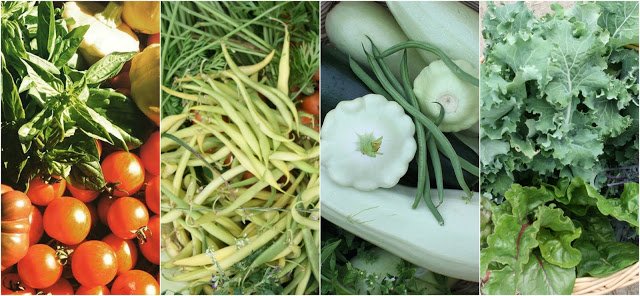
Polyculture Yields
Financial output - Profit - The market value of the produce is estimated based on the average prices we were receiving from local buyers, veggie boxes and Trustika buyers club in Sofia.
N.B. We do not sell all of the produce from the garden. Some of the produce is consumed by the team or preserved.
What we Record - Surveys
Soil Analysis - Each spring and autumn we obtain a soil sample and send it to NAAS of the Ministry of Agriculture and Food. To take a sample we take approx. a hand trowel full of the top 20 cm of soil from 8 random areas from the beds, mix it together and send 400 g "bagged and tagged" to the lab the same day.
Physical Analysis - Each spring the team carry out a series of 9 tests that are designed to provide an indication of soil health based on observable physical properties of the soil. It's a soil management tool developed by farmers for farmers to track the developing health of soils. We have slightly modified the test for our purposes.
Regenerative Landscape Design Course participants working through the soil health test cards
Invertebrate Survey - Entomologist Chris Kirby-Lambert undertook three surveys in the gardens. You can find his Outline of Invertebrate Diversity Monitoring Project here We are looking forward to see the results during the winter once the invertebrates have been identified and recorded.
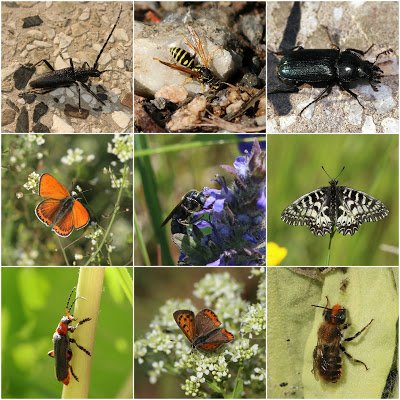
A sample of invertebrates from the gardens- Photos by Chris Kirby-Lambert
Pest and Disease - Thanks to Victoria Bezhitashvili, who joined us for the study this year, we also have a general record of some of the pests and diseases in the vegetable garden this year. You can find Victoria's observations here.
Results
We'll start off by looking at the results from the soil analysis and soil health tests, then look at the results for each polyculture and finally finish up with the overall garden results.
Soil Results - Mineral Analysis
Each spring and autumn we take soil samples and send them to NAAS of the Ministry of Agriculture and Food. The sample is taken before we add any fertility in March at the beginning of the season.
The first sample taken in March 2015 in the table below is the base sample taken before work in the garden began.
See here for tables - http://balkanecologyproject.blogspot.com/2018/12/the-polyculture-market-garden-study.html
Soil Results - Soil Health Card
This year's soil health card test scored 63.9 - a small decrease from last year's test of 65.6. The highest score obtainable for this test is 88.
You can find the full results from 2015 - 2018 in the spreadsheet 2018 Annual Polyculture Market Garden Study - Published Records - Sheet 6.Soil Test Cards
Should you wish to use this soil card you can download the Soil Health Card forms with instructions on how to carry out the tests here.
Inputs and Outputs - Epictetus
The total amount of time spent on Epictetus was 25 hrs. The time inputs are recorded into different categories as seen below.
Task Time in mins
Fertility 72
Planting /Sowing 320
Garden Care 592
Irrigation 180
Harvesting 170
Propagation 170
Total hrs 25 hrs
The fertility inputs on Epictetus were as follows:
Fertility Inputs Total Quantity
Mulch - Lawn Mower Clipping 540 L
Mulch - Spot Mulching 1 Bale
Wood Ash 6.720kg
Seedling mix for Beans 14 L
Compost planting out Kale 30 L
Compost for sowing beetroot strips 100 L
Seedling mix for Sowing Parsnips and Beetroots 75 L
Compost for Propagation 90L
Seedling Mix for Propagation 87 L
Compost added to beds 460 L
The yield outputs for Epictetus totalled 68.05 kg of produce. This is around 1.23 kg of produce per m2.
Crop Weight in g per bed
Dwarf Beans (Fresh) 4255
Kale 4385
Chard 1340
Beetroot 14380
Parsnip 8740
Turnip 925
Total 68.05 kg
N.B At the time of publishing this post (03/12/18) there are still parsnips and kale, the yields of which have been estimated for these records.
Inputs and Outputs - Zeno
The amount of time spent on Zeno was 36 hrs.
Task Time in mins
Set up 222
Planting /Sowing 322
Garden Care 595
Irrigation 180
Harvesting 600
Propagation 245
Total hrs 36
The fertility inputs on Zeno were as follows:
Fertility Inputs
Item Total Quantity
Strawbales 31
Compost for
Tomatoes (L) 17.6 L
Seedling Mix
for Squash (L) 10.4 L
Seedling mix for Beans (L) 13.2 L
Wood Ash kg 6.72 kg
Mulch - Lawn Mower Clipping (L) 540 L
The yield outputs for Zeno totalled 237.23 kg of produce - 4.3 kg per m2.
Crop Weight in g
Tomatoes 20640
Tomatoes - (Processing) 1770
Beans 33140
Courgette 42425
Tomato (projected) 20640
Basil 995
Total 237.23kg
Inputs and Outputs - Zeno Control
The amount of time spent on Zeno Control was 35 hrs and 20 mins.
Task Time in mins
Set up 318
Planting /Sowing 444
Garden Care 333
Irrigation 180
Harvesting 600
Propagation 245
Total hrs 35 hrs 20 mins
The fertility inputs on Zeno control were as follows:
Fertility Inputs
Item Total Quantity
Strawbales 31
Compost for
Tomatoes (L) 17.6 L
Seedling Mix
for Squash (L) 10.4 L
Seedling mix for Beans (L) 13.2 L
Wood Ash kg 6.72 kg
Mulch - Lawn Mower Clipping (L) 540 L
The yield outputs for Zeno totalled 191.57 kg of produce - 3.47 kg per m2.
Crop Weight in g
Tomatoes 11895
Tomatoes - (Processing) 2450
Beans 23770
Courgette 41880
Tomato (projected) 11895
Basil 3895
Total 191.57 kg
Some of the "time" categories were difficult to assign to each polyculture so I clumped them together into a general task category. It's mainly the time preparing the produce for market as well as soil analysis, initial propagation tasks and end of season tidying up and packing away of the garden.
General Tasks
Task Time in mins
Fertility 24
Analysis 10
Set up 180
Market Prep 2400
Mowing 540
Total hrs 52 hrs 30 mins
Zeno Polyculture vs the Control
This year's results show the polyculture outperforming the control in yield by approx 46 kg and taking approx. 45 minutes longer to manage.
This year's results
Zeno Control
Total time 36 hrs 5 min 35 hrs 20 min
Total Produce 237.23 kg 191.57 kg
Last year's results
Zeno Control
Total time 37 hrs 5 min 37 hrs 30 min
Total Produce 154.429 kg 140.670 kg
You can find the above results in the spreadsheet 2018 Annual Polyculture Market Garden Study - Published Records - Sheet 9. Inputs and Outputs per Trial. For date stamped harvest records for Zeno see here and for Epictetus see here.
Inputs and Outputs - All Beds
Aponia - The Polyculture Market Garden
The amount of time spent on all beds was 149 hrs.
Time
Tasks Minutes Hours
Fertility 96 1.6
Analysis 10 0.16
Set up 720 12
Market Prep 2400 40
Mowing 540 9
Planting /Sowing 1086 18.1
Garden Care 1520 25.3
Irrigation 540 9
Harvesting 1370 22.8
Propagation 660 11
Total time input 149 hrs

% of 149 hours spent on various activities in the market garden.
The fertility inputs for all beds were as follows:
Fertility Inputs
Total inputs for garden
Strawbales 63 bales
Compost 1205 L
Wood Ash 20 kg
Sieved Compost
/River Sand 50 /50 224 L
Lawn Clippings 1620 L
The yield outputs for all beds totaled 498.84 kg of produce or 4.51 kg per m2.
.png)
Produce all beds
Product Weight in g Average weight in
g per m 2
Dwarf Beans (Fresh) 8510 154.17
Kale 8770 158.88
Chard 2680 48.55
Beetroot 28760 521.01
Parsnip 17480 316.67
Turnip 1850 16.76
Tomatoes 130140 1178.80
Tomatoes - (Processing) 8440 76.45
Beans 113820 1030.98
Courgette 168610 1527.26
Basil 9780 88.59
Total kg 498.84
Some shots of the market garden
Results in Summary
The garden produced just under half a ton of produce from a cultivated area of 165.6 m2.
The time spent on the garden was 149 hrs from sowing the first seeds indoors in February to packing up in late October.
The fertility inputs of the garden were 63 Straw bales, 1205 L of compost. 20 kg of wood ash, 224 L of sowing medium, 1620 L of lawn clippings.
Comments on Results
Time Input
Not included in the records were other tasks carried out around the site such as making compost, harvesting stakes and support sticks, establishing beneficial habitat such as wildlife ponds, hedgerows/stick piles.
The time for preparing the produce for market i.e quality control, packaging and delivery, was estimated at 2 hrs per week per culture.
Financial Inputs - Costs
Not included here are the set up costs for the garden. These costs were included in the first years results. The costs recorded here are the annual operating costs which is basically the cost of seed, and fuel,oil and maintenance for the lawn mower.
Financial Output - Income
A polyculture market garden should have a polyculture of revenue. Our study currently focuses on annual vegetable production. We chose to begin our study of annual vegetables as it is the most accessible practice to most people requiring the least amount of investment making it ideal for a novice or curious grower. This year we have started planting up various perennial polyculture trails in our new garden Ataraxia. You can find out more about these trials here
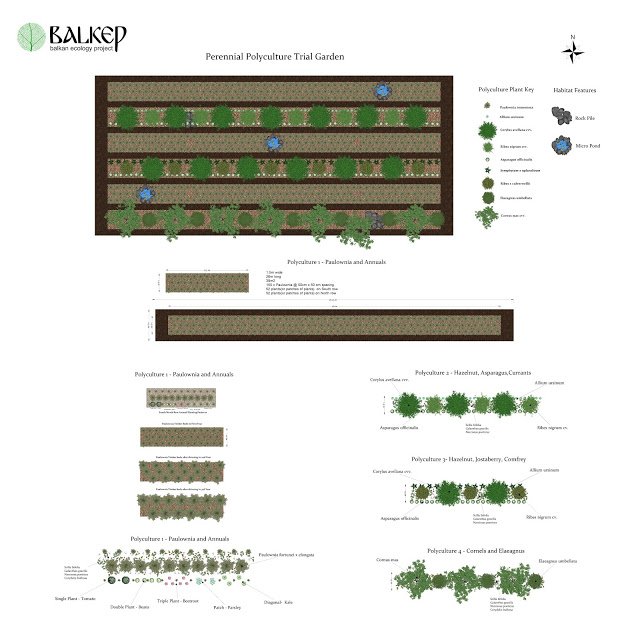
Perennial Polyculture Trials in Ataraxia
Other potential revenue from the Polyculture Market Garden includes perennial crops, plant nursery, adding value to produce and courses and training. We plan to add a record of these activities to represent better the financial potential of a Polyculture Market Garden.
Estimated Harvests
At the time of writing this report there are still crops growing in Epictetus. We estimated the harvest weights of the remaining crops based on what we had already harvested.
Epictetus bed with Parsnips and Kale yet to be harvested. These can remain in the beds until the new year.
Considerations :-
We usually aim to grow at least 5 different tomato cultivars but this year we only used 2 cultivars and one of them was cultivar 'Currant Sweet Pea'. This was a mistake and although they performed very well in the gardens and are very tasty they are ridiculously small and for this reason we decided not to include them in the weight records. Instead we used the Tigerella yields to provide an estimated forecast of what we may have harvested.
We usually aim to grow equal numbers of the same cultivar in the polyculture and the control but this year our courgette cultivars were not distributed equally.
The warm and wet summer reduced our irrigation needs significantly this year with only 6 weeks of the season requiring water (aside from watering of the seedlings in early spring) . We did however need to mow the garden more often due the optimal growing conditions.
Here is a slideshow of our activity from the season
N.B. We took base times for the majority of tasks carried out in the gardens in the first two years of the study. These tasks were carried out by a volunteer team that had little or no prior experience in horticulture. An experienced grower or with repeated experience of these cultivation methods should be able to reduce the task times significantly.
You can access the full spreadsheet here that includes all of the data entries and task descriptions. (note there are multiple sheets that can be accessed from the blue tabs running along the top of the sheet).
Why are we doing this research?
If you are reading this you're most probably aware of the environmental damage caused by industrial agricultural practices. We believe this damage is unnecessary, and aim to provide healthier models of food production that yield nutritious affordable food while at the same time promoting biodiversity and general ecosystem health.

Polyculture gardens providing food for humans and other organisms
Industrial methods are heavily researched and funded, and there is a general belief among many farmers and growers that this is the only practical way of operating. Following 12 years of cultivating polyculture gardens we are seeing that small scale biologically cultivated polyculture gardens are a realistic and practical way of providing food for humans whilst preserving biodiversity and general health in the environment. Furthermore, we believe this type of agriculture can help create thriving local economies that strengthen community, provide dignified work and enhance the amenity value of an area.
Little data exists showing the productive capacity of polyculture systems and the economic viability of them. I believe there is a need to fill this gap and provide data and concise coherent models that can be replicated easily. This project intends to go some of the way to achieve that.
We aim to address the following questions;
How productive can polycultures be?
What advantages can polycultures provide ?
How much time do polyculture gardens take to establish and manage?
How economically viable are these gardens?
How bio-diverse can our food producing systems be?
Can we provide clean, nutritious, affordable food whilst enhancing biodiversity?
I make no claim that polyculture can feed the world but I do claim with 100% conviction that anyone can grow polycultures and by doing so they are taking a small but significant step in reversing at least a small portion of the damage that industrial agriculture creates.
Want to get involved? Sharing, Feedback and Collaboration
We have our record keeping spreadsheets available on Google sheets and Excel. These sheets include all of the data entries and task descriptions (note there are multiple sheets that can be accessed from the blue tabs running along the top of the sheet). If you would like to keep your own records or replicate our trial we'd be happy to give you a copy of the spreadsheet, just drop us an email or leave a comment below with your contact details and we will send it over to you.
If you have any suggestions and feedback on how you think we could improve the study or you have heard about or practice similar studies on other guild/polycultures we'd love to hear from you.
If you'd like to join next year's study registration is open now - http://www.balkep.org/the-polyculture-market-garden-study.html
If you would like to create a forest garden and gain some practical hands on experience join us this Spring. We'll be covering site surveying, landscape design software, installing access, beds, irrigation channels, planting tree, shrub, herb and ground layers and making a small wildlife pond. All in 3 days! And plenty of follow up material to take away with you to digest slowly.
.jpg)
http://www.balkep.org/design-and-build---regenerative-landscape-design-course.html
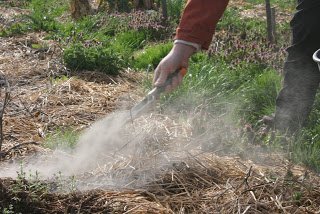


.JPG)
Source
Plagiarism is the copying & pasting of others work without giving credit to the original author or artist. Plagiarized posts are considered spam.
Spam is discouraged by the community, and may result in action from the cheetah bot.
More information and tips on sharing content.
If you believe this comment is in error, please contact us in #disputes on Discord
Hi! I am a robot. I just upvoted you! I found similar content that readers might be interested in:
http://balkanecologyproject.blogspot.com/2017/11/the-polyculture-market-garden-study.html
Thank you so much for sharing this amazing post with us!
Have you heard about Partiko? It’s a really convenient mobile app for Steem! With Partiko, you can easily see what’s going on in the Steem community, make posts and comments (no beneficiary cut forever!), and always stayed connected with your followers via push notification!
Partiko also rewards you with Partiko Points (3000 Partiko Point bonus when you first use it!), and Partiko Points can be converted into Steem tokens. You can earn Partiko Points easily by making posts and comments using Partiko.
We also noticed that your Steem Power is low. We will be very happy to delegate 15 Steem Power to you once you have made a post using Partiko! With more Steem Power, you can make more posts and comments, and earn more rewards!
If that all sounds interesting, you can:
Thank you so much for reading this message!